DODGE DURANGO 2011 3.G Owners Manual
Manufacturer: DODGE, Model Year: 2011, Model line: DURANGO, Model: DODGE DURANGO 2011 3.GPages: 576, PDF Size: 3.57 MB
Page 91 of 576
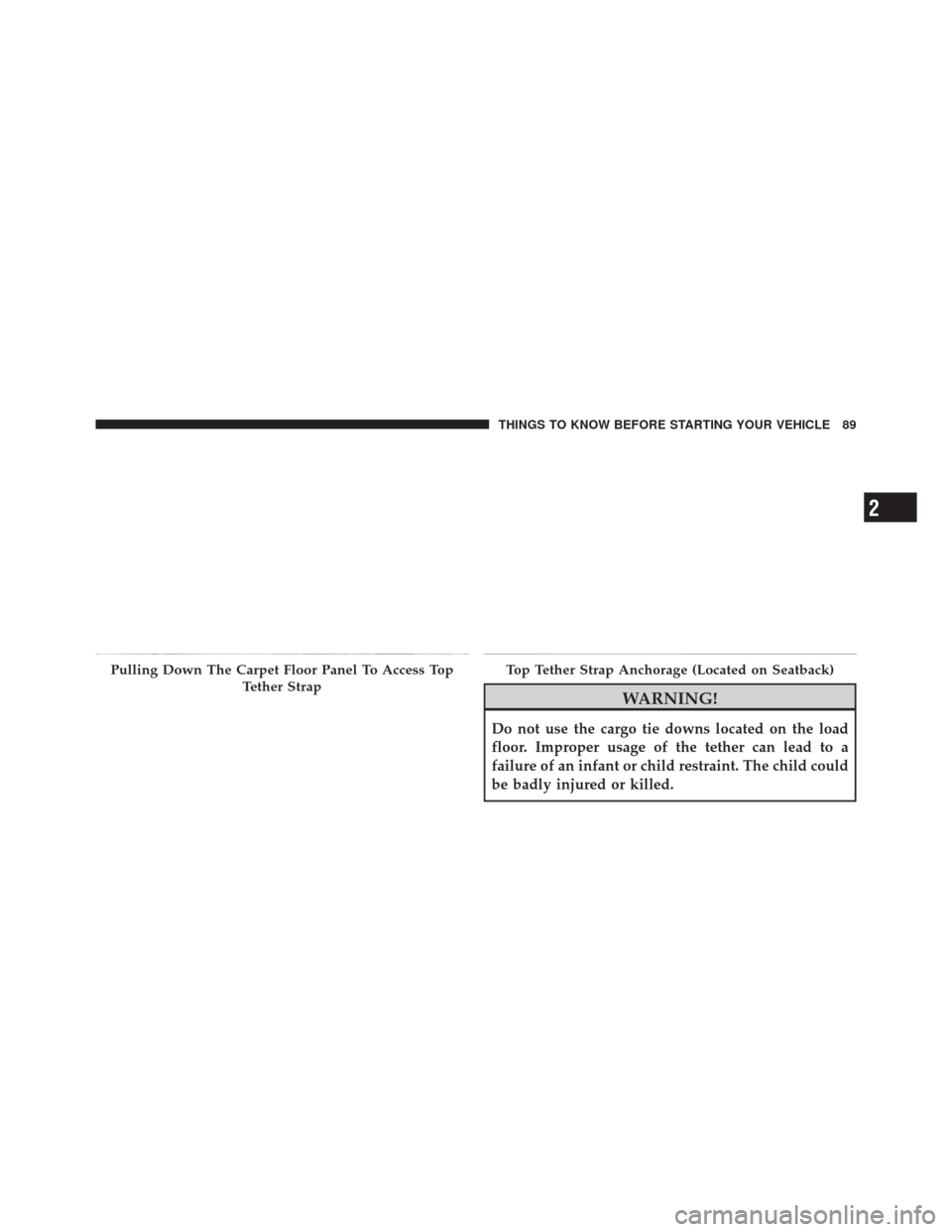
WARNING!
Do not use the cargo tie downs located on the load
floor. Improper usage of the tether can lead to a
failure of an infant or child restraint. The child could
be badly injured or killed.
Pulling Down The Carpet Floor Panel To Access TopTether StrapTop Tether Strap Anchorage (Located on Seatback)
2
THINGS TO KNOW BEFORE STARTING YOUR VEHICLE 89
Page 92 of 576
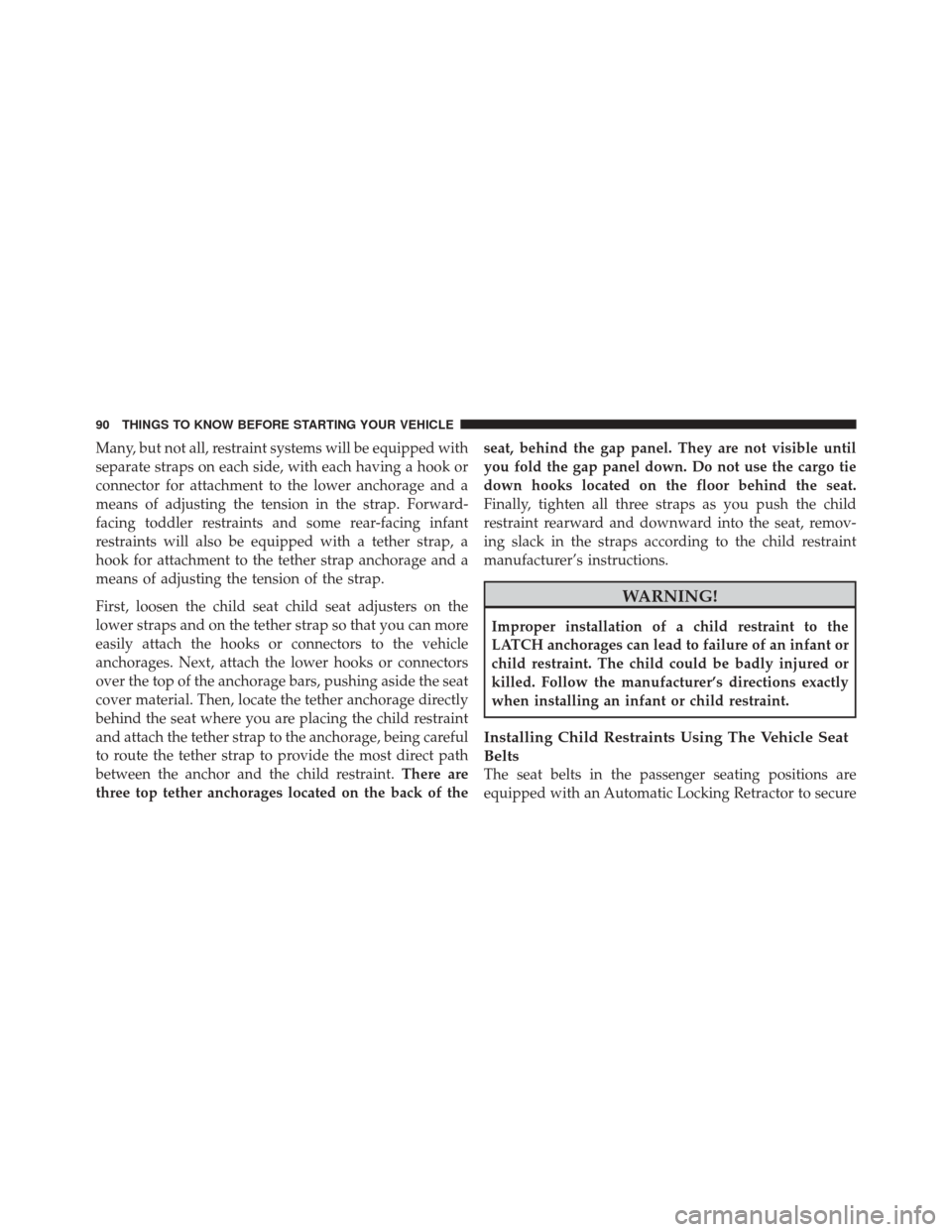
Many, but not all, restraint systems will be equipped with
separate straps on each side, with each having a hook or
connector for attachment to the lower anchorage and a
means of adjusting the tension in the strap. Forward-
facing toddler restraints and some rear-facing infant
restraints will also be equipped with a tether strap, a
hook for attachment to the tether strap anchorage and a
means of adjusting the tension of the strap.
First, loosen the child seat child seat adjusters on the
lower straps and on the tether strap so that you can more
easily attach the hooks or connectors to the vehicle
anchorages. Next, attach the lower hooks or connectors
over the top of the anchorage bars, pushing aside the seat
cover material. Then, locate the tether anchorage directly
behind the seat where you are placing the child restraint
and attach the tether strap to the anchorage, being careful
to route the tether strap to provide the most direct path
between the anchor and the child restraint.There are
three top tether anchorages located on the back of the seat, behind the gap panel. They are not visible until
you fold the gap panel down. Do not use the cargo tie
down hooks located on the floor behind the seat.
Finally, tighten all three straps as you push the child
restraint rearward and downward into the seat, remov-
ing slack in the straps according to the child restraint
manufacturer’s instructions.
WARNING!
Improper installation of a child restraint to the
LATCH anchorages can lead to failure of an infant or
child restraint. The child could be badly injured or
killed. Follow the manufacturer’s directions exactly
when installing an infant or child restraint.
Installing Child Restraints Using The Vehicle Seat
Belts
The seat belts in the passenger seating positions are
equipped with an Automatic Locking Retractor to secure
90 THINGS TO KNOW BEFORE STARTING YOUR VEHICLE
Page 93 of 576
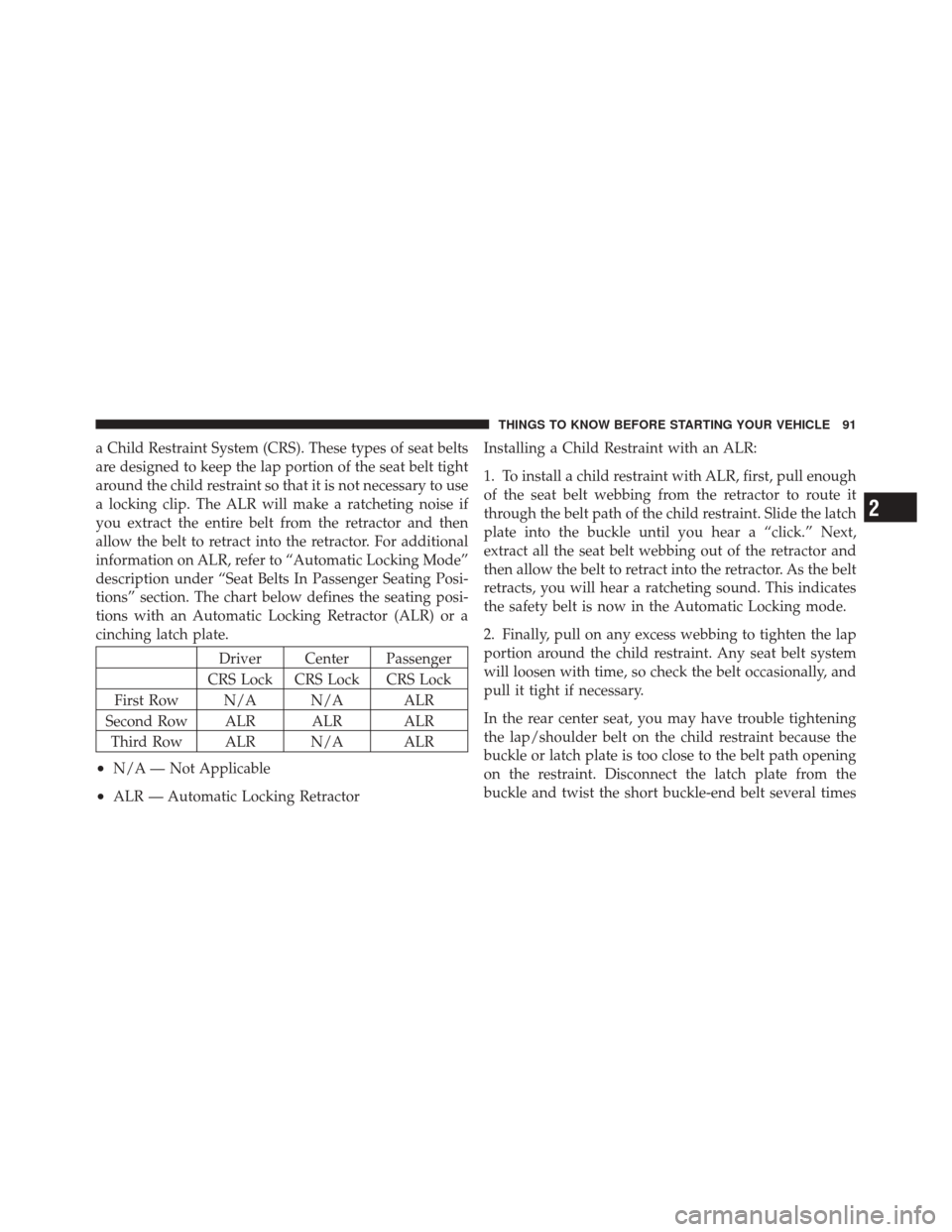
a Child Restraint System (CRS). These types of seat belts
are designed to keep the lap portion of the seat belt tight
around the child restraint so that it is not necessary to use
a locking clip. The ALR will make a ratcheting noise if
you extract the entire belt from the retractor and then
allow the belt to retract into the retractor. For additional
information on ALR, refer to “Automatic Locking Mode”
description under “Seat Belts In Passenger Seating Posi-
tions” section. The chart below defines the seating posi-
tions with an Automatic Locking Retractor (ALR) or a
cinching latch plate.
Driver Center Passenger
CRS Lock CRS Lock CRS Lock
First Row N/A N/A ALR
Second Row ALR ALR ALR Third Row ALR N/A ALR
•N/A — Not Applicable
•ALR — Automatic Locking Retractor Installing a Child Restraint with an ALR:
1. To install a child restraint with ALR, first, pull enough
of the seat belt webbing from the retractor to route it
through the belt path of the child restraint. Slide the latch
plate into the buckle until you hear a “click.” Next,
extract all the seat belt webbing out of the retractor and
then allow the belt to retract into the retractor. As the belt
retracts, you will hear a ratcheting sound. This indicates
the safety belt is now in the Automatic Locking mode.
2. Finally, pull on any excess webbing to tighten the lap
portion around the child restraint. Any seat belt system
will loosen with time, so check the belt occasionally, and
pull it tight if necessary.
In the rear center seat, you may have trouble tightening
the lap/shoulder belt on the child restraint because the
buckle or latch plate is too close to the belt path opening
on the restraint. Disconnect the latch plate from the
buckle and twist the short buckle-end belt several times
2
THINGS TO KNOW BEFORE STARTING YOUR VEHICLE 91
Page 94 of 576
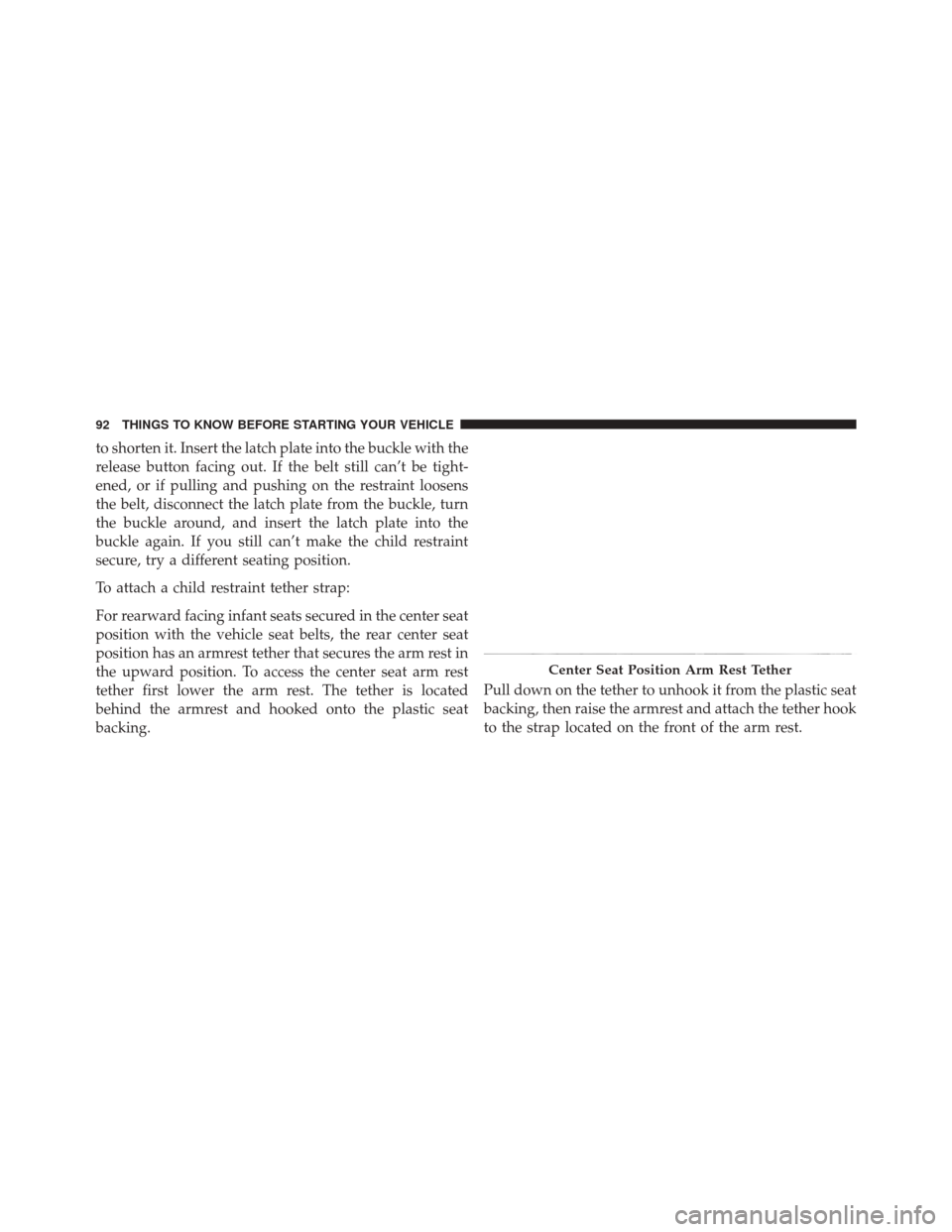
to shorten it. Insert the latch plate into the buckle with the
release button facing out. If the belt still can’t be tight-
ened, or if pulling and pushing on the restraint loosens
the belt, disconnect the latch plate from the buckle, turn
the buckle around, and insert the latch plate into the
buckle again. If you still can’t make the child restraint
secure, try a different seating position.
To attach a child restraint tether strap:
For rearward facing infant seats secured in the center seat
position with the vehicle seat belts, the rear center seat
position has an armrest tether that secures the arm rest in
the upward position. To access the center seat arm rest
tether first lower the arm rest. The tether is located
behind the armrest and hooked onto the plastic seat
backing.Pull down on the tether to unhook it from the plastic seat
backing, then raise the armrest and attach the tether hook
to the strap located on the front of the arm rest.
Center Seat Position Arm Rest Tether
92 THINGS TO KNOW BEFORE STARTING YOUR VEHICLE
Page 95 of 576
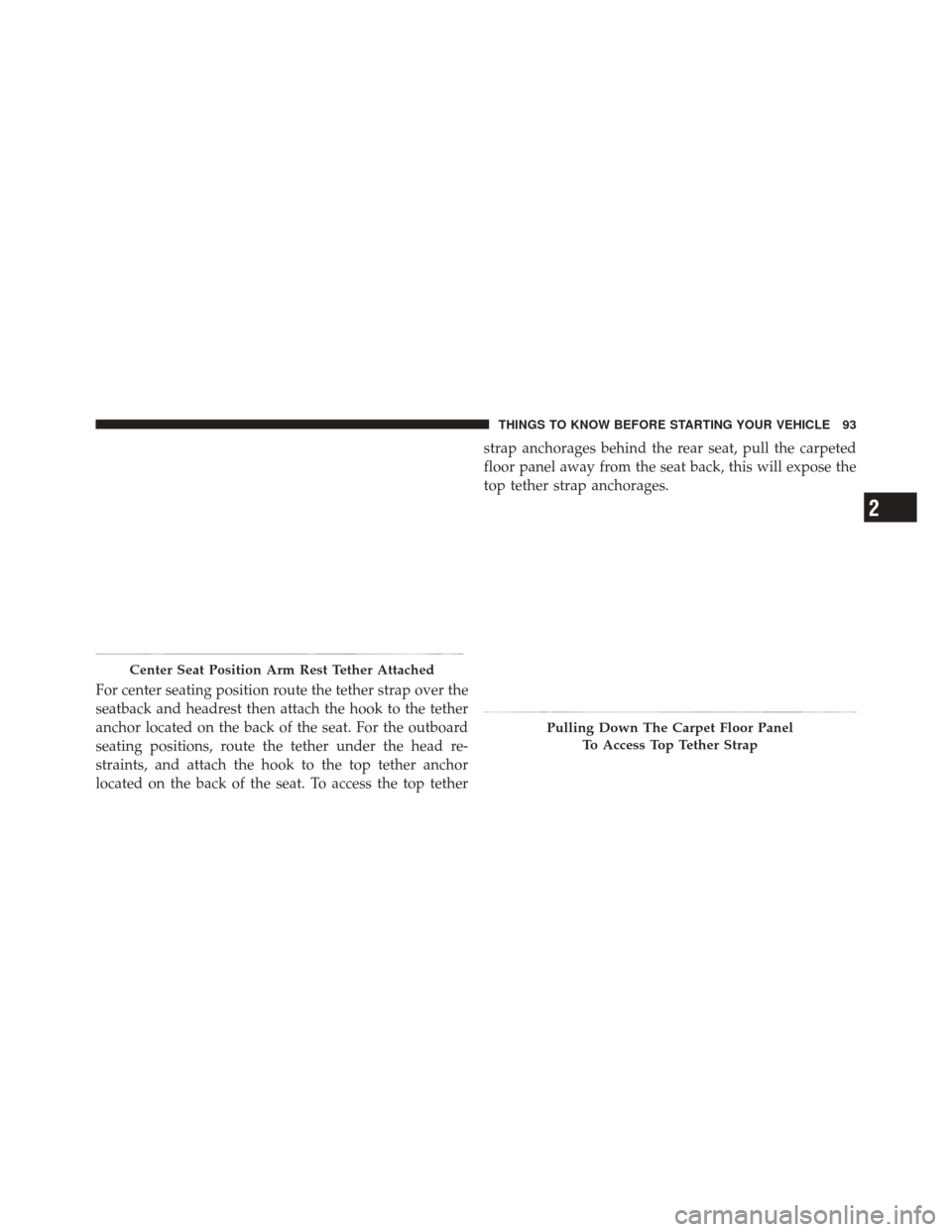
For center seating position route the tether strap over the
seatback and headrest then attach the hook to the tether
anchor located on the back of the seat. For the outboard
seating positions, route the tether under the head re-
straints, and attach the hook to the top tether anchor
located on the back of the seat. To access the top tetherstrap anchorages behind the rear seat, pull the carpeted
floor panel away from the seat back, this will expose the
top tether strap anchorages.
Center Seat Position Arm Rest Tether Attached
Pulling Down The Carpet Floor Panel
To Access Top Tether Strap
2
THINGS TO KNOW BEFORE STARTING YOUR VEHICLE 93
Page 96 of 576
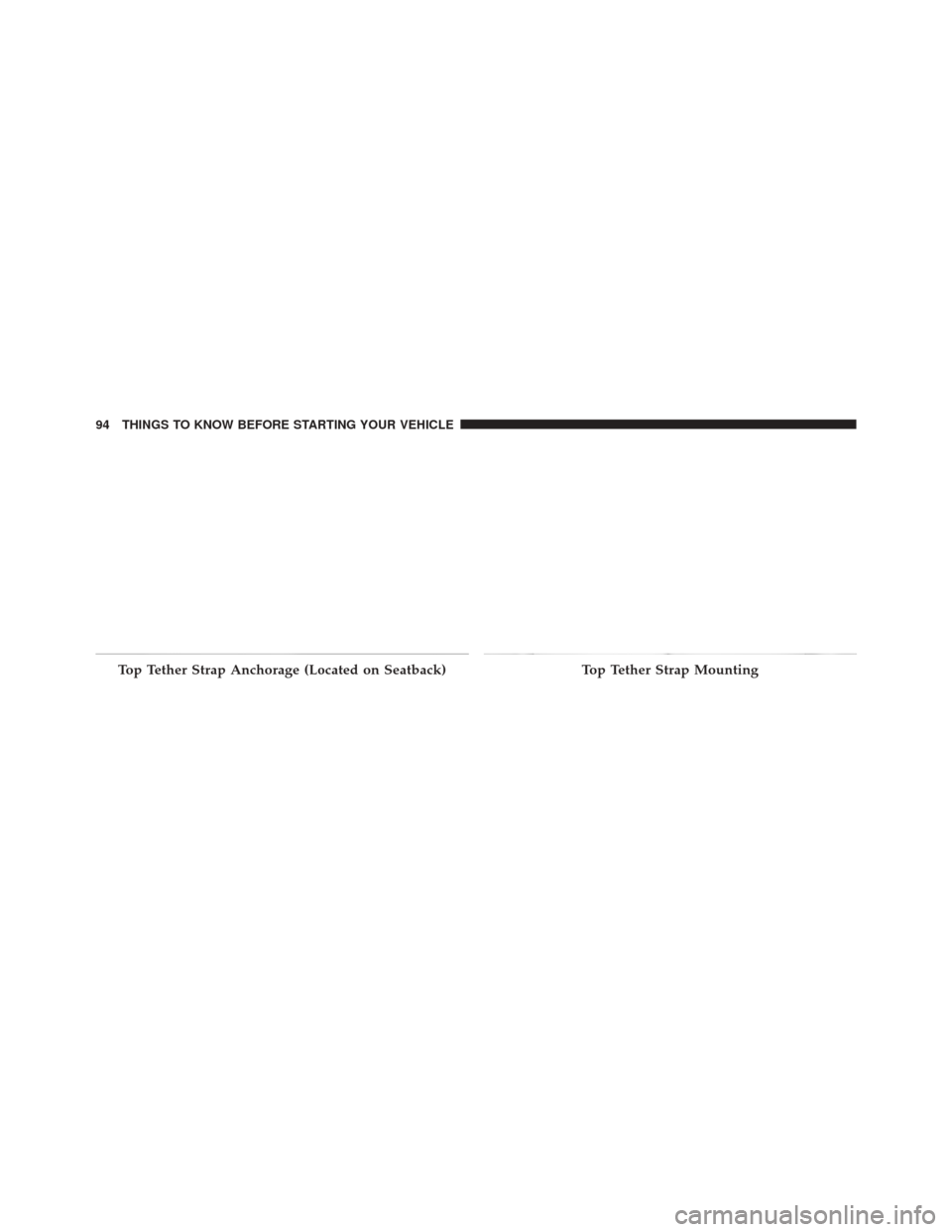
Top Tether Strap Anchorage (Located on Seatback)Top Tether Strap Mounting
94 THINGS TO KNOW BEFORE STARTING YOUR VEHICLE
Page 97 of 576
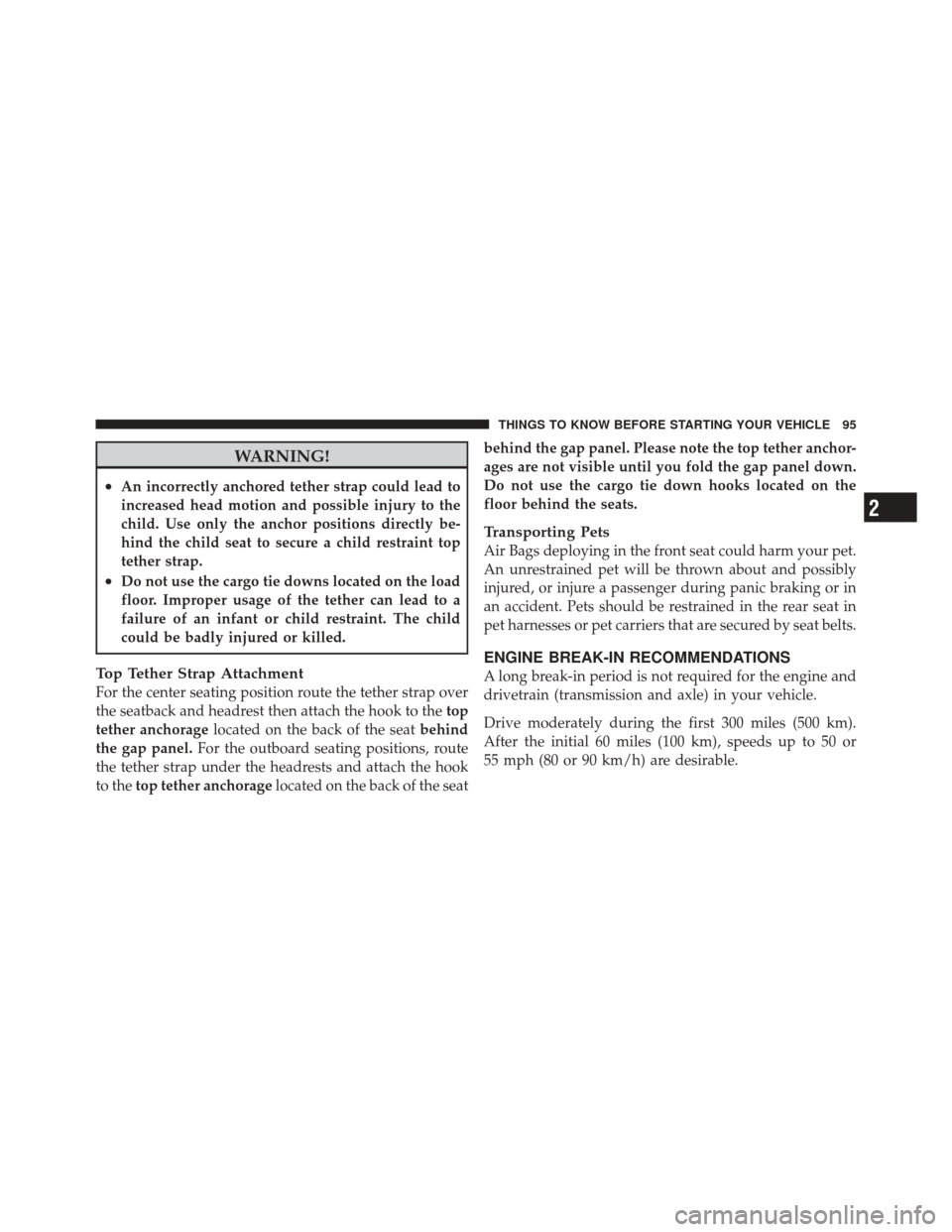
WARNING!
•An incorrectly anchored tether strap could lead to
increased head motion and possible injury to the
child. Use only the anchor positions directly be-
hind the child seat to secure a child restraint top
tether strap.
•Do not use the cargo tie downs located on the load
floor. Improper usage of the tether can lead to a
failure of an infant or child restraint. The child
could be badly injured or killed.
Top Tether Strap Attachment
For the center seating position route the tether strap over
the seatback and headrest then attach the hook to thetop
tether anchorage located on the back of the seat behind
the gap panel. For the outboard seating positions, route
the tether strap under the headrests and attach the hook
to the top tether anchorage located on the back of the seat behind the gap panel. Please note the top tether anchor-
ages are not visible until you fold the gap panel down.
Do not use the cargo tie down hooks located on the
floor behind the seats.
Transporting Pets
Air Bags deploying in the front seat could harm your pet.
An unrestrained pet will be thrown about and possibly
injured, or injure a passenger during panic braking or in
an accident. Pets should be restrained in the rear seat in
pet harnesses or pet carriers that are secured by seat belts.
ENGINE BREAK-IN RECOMMENDATIONS
A long break-in period is not required for the engine and
drivetrain (transmission and axle) in your vehicle.
Drive moderately during the first 300 miles (500 km).
After the initial 60 miles (100 km), speeds up to 50 or
55 mph (80 or 90 km/h) are desirable.
2
THINGS TO KNOW BEFORE STARTING YOUR VEHICLE 95
Page 98 of 576
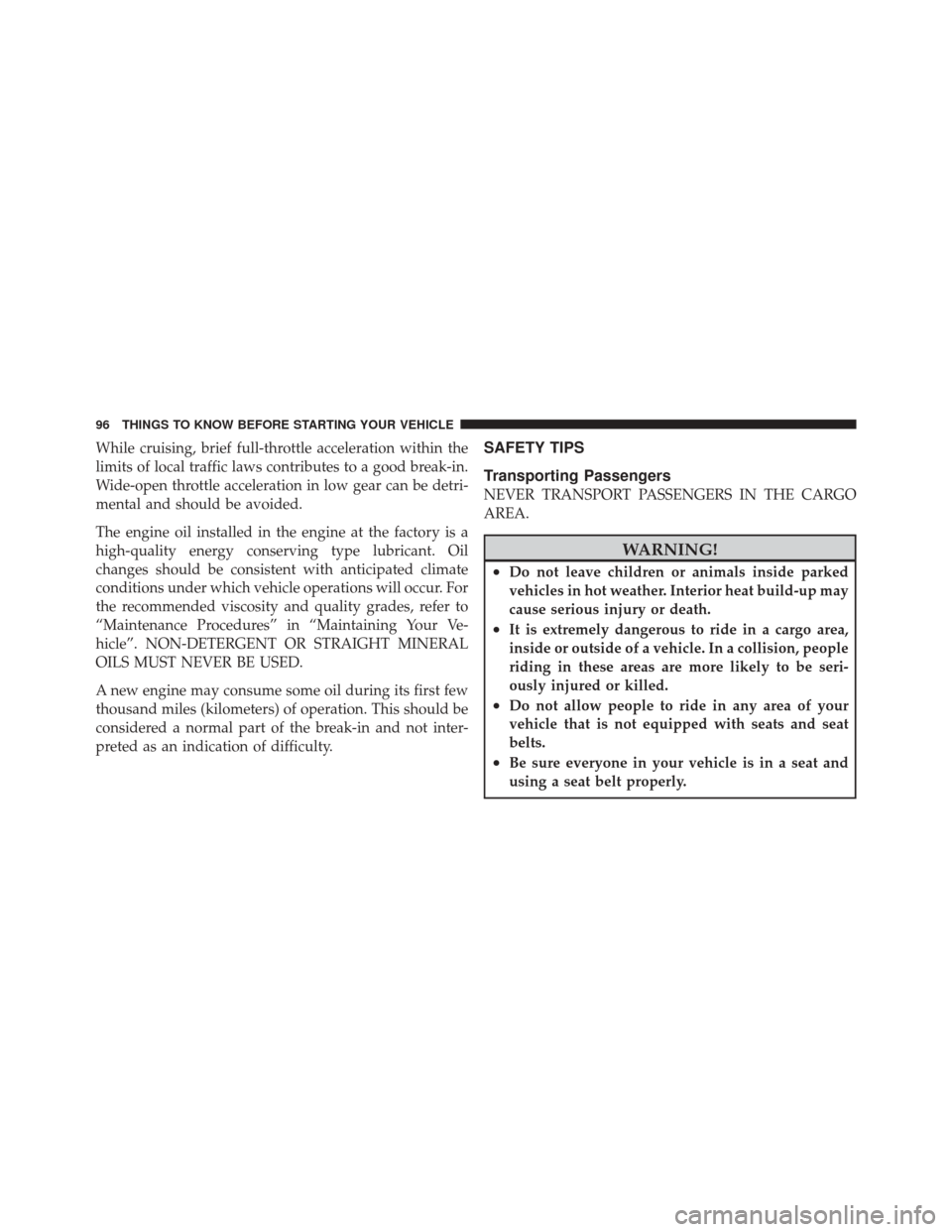
While cruising, brief full-throttle acceleration within the
limits of local traffic laws contributes to a good break-in.
Wide-open throttle acceleration in low gear can be detri-
mental and should be avoided.
The engine oil installed in the engine at the factory is a
high-quality energy conserving type lubricant. Oil
changes should be consistent with anticipated climate
conditions under which vehicle operations will occur. For
the recommended viscosity and quality grades, refer to
“Maintenance Procedures” in “Maintaining Your Ve-
hicle”. NON-DETERGENT OR STRAIGHT MINERAL
OILS MUST NEVER BE USED.
A new engine may consume some oil during its first few
thousand miles (kilometers) of operation. This should be
considered a normal part of the break-in and not inter-
preted as an indication of difficulty.SAFETY TIPS
Transporting Passengers
NEVER TRANSPORT PASSENGERS IN THE CARGO
AREA.
WARNING!
•Do not leave children or animals inside parked
vehicles in hot weather. Interior heat build-up may
cause serious injury or death.
•It is extremely dangerous to ride in a cargo area,
inside or outside of a vehicle. In a collision, people
riding in these areas are more likely to be seri-
ously injured or killed.
•Do not allow people to ride in any area of your
vehicle that is not equipped with seats and seat
belts.
•Be sure everyone in your vehicle is in a seat and
using a seat belt properly.
96 THINGS TO KNOW BEFORE STARTING YOUR VEHICLE
Page 99 of 576
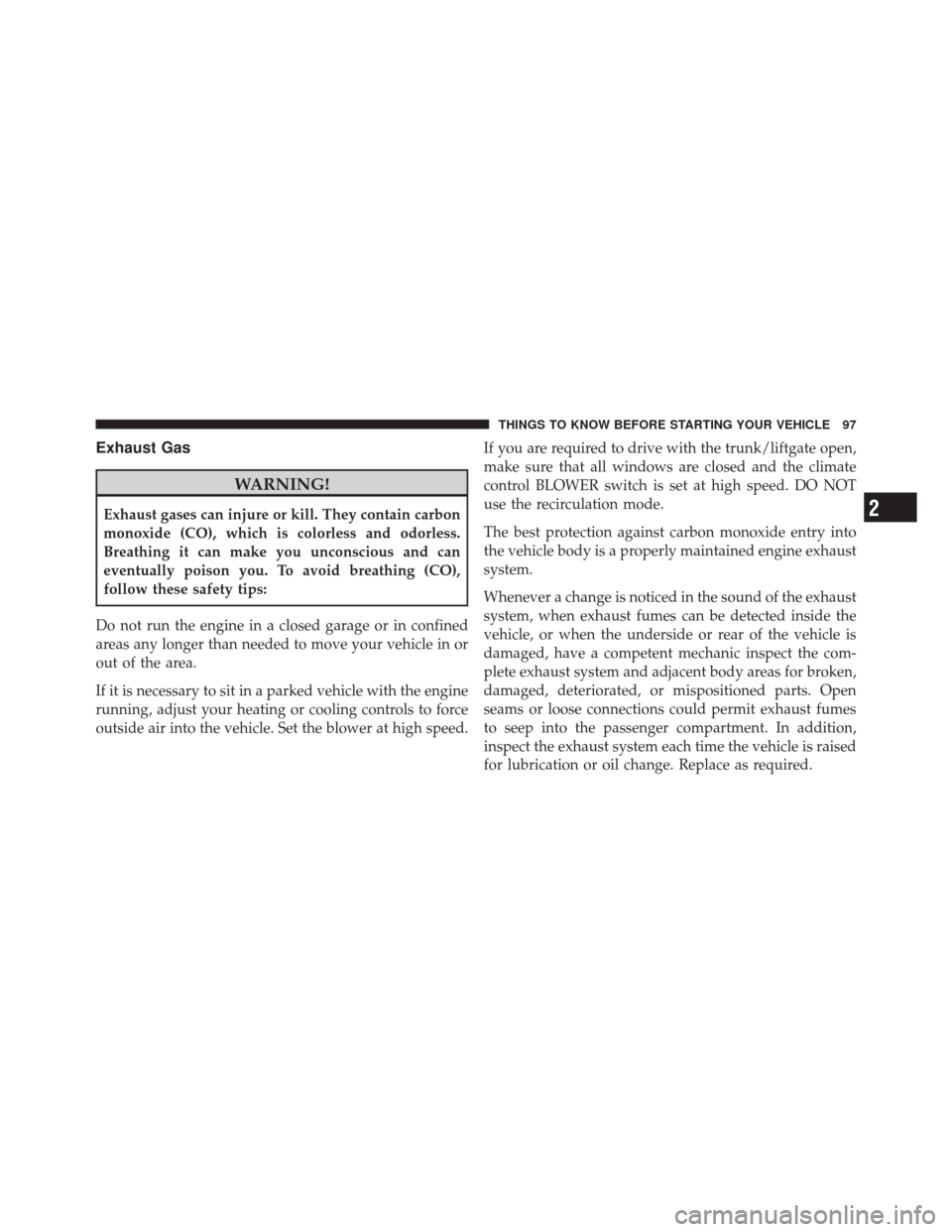
Exhaust Gas
WARNING!
Exhaust gases can injure or kill. They contain carbon
monoxide (CO), which is colorless and odorless.
Breathing it can make you unconscious and can
eventually poison you. To avoid breathing (CO),
follow these safety tips:
Do not run the engine in a closed garage or in confined
areas any longer than needed to move your vehicle in or
out of the area.
If it is necessary to sit in a parked vehicle with the engine
running, adjust your heating or cooling controls to force
outside air into the vehicle. Set the blower at high speed. If you are required to drive with the trunk/liftgate open,
make sure that all windows are closed and the climate
control BLOWER switch is set at high speed. DO NOT
use the recirculation mode.
The best protection against carbon monoxide entry into
the vehicle body is a properly maintained engine exhaust
system.
Whenever a change is noticed in the sound of the exhaust
system, when exhaust fumes can be detected inside the
vehicle, or when the underside or rear of the vehicle is
damaged, have a competent mechanic inspect the com-
plete exhaust system and adjacent body areas for broken,
damaged, deteriorated, or mispositioned parts. Open
seams or loose connections could permit exhaust fumes
to seep into the passenger compartment. In addition,
inspect the exhaust system each time the vehicle is raised
for lubrication or oil change. Replace as required.2
THINGS TO KNOW BEFORE STARTING YOUR VEHICLE 97
Page 100 of 576
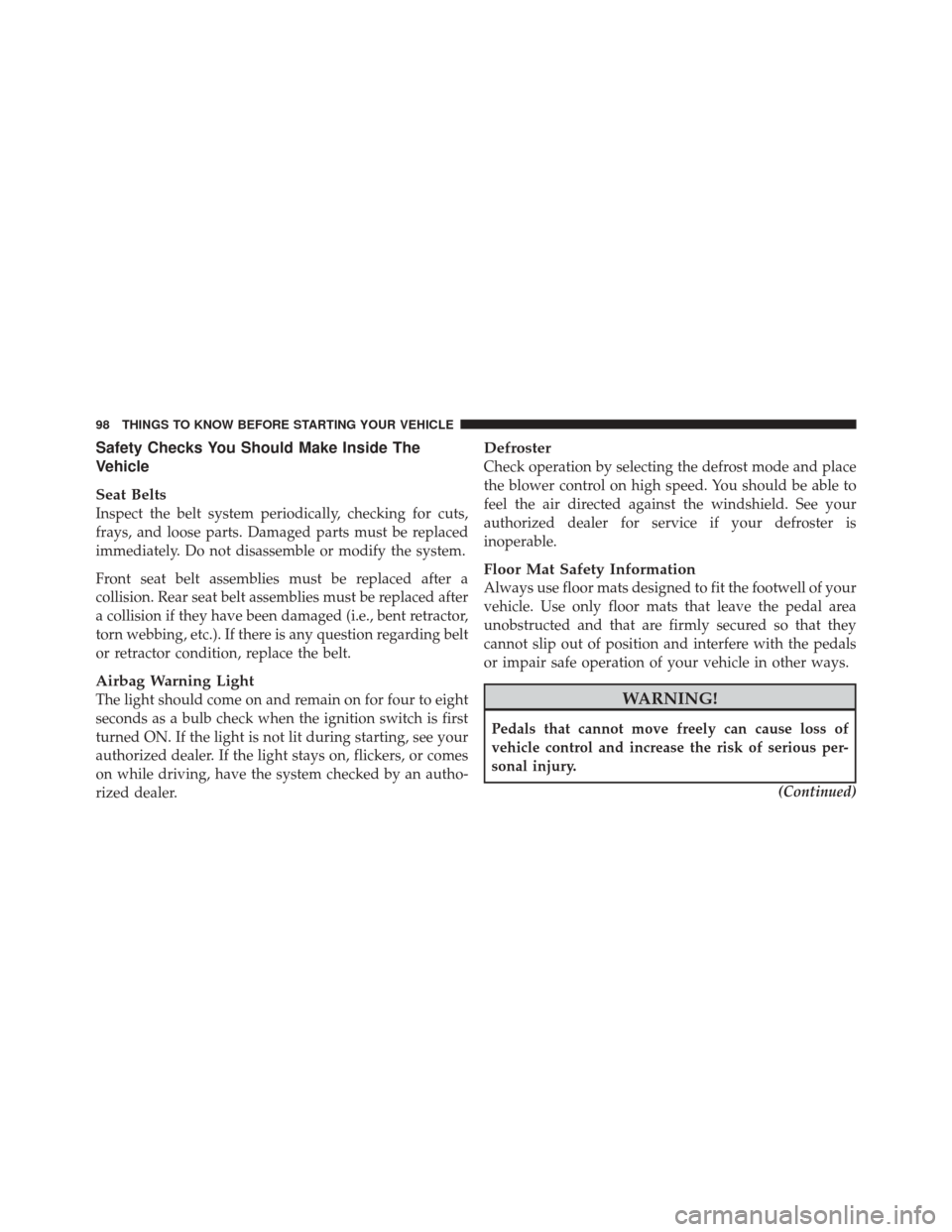
Safety Checks You Should Make Inside The
Vehicle
Seat Belts
Inspect the belt system periodically, checking for cuts,
frays, and loose parts. Damaged parts must be replaced
immediately. Do not disassemble or modify the system.
Front seat belt assemblies must be replaced after a
collision. Rear seat belt assemblies must be replaced after
a collision if they have been damaged (i.e., bent retractor,
torn webbing, etc.). If there is any question regarding belt
or retractor condition, replace the belt.
Airbag Warning Light
The light should come on and remain on for four to eight
seconds as a bulb check when the ignition switch is first
turned ON. If the light is not lit during starting, see your
authorized dealer. If the light stays on, flickers, or comes
on while driving, have the system checked by an autho-
rized dealer.
Defroster
Check operation by selecting the defrost mode and place
the blower control on high speed. You should be able to
feel the air directed against the windshield. See your
authorized dealer for service if your defroster is
inoperable.
Floor Mat Safety Information
Always use floor mats designed to fit the footwell of your
vehicle. Use only floor mats that leave the pedal area
unobstructed and that are firmly secured so that they
cannot slip out of position and interfere with the pedals
or impair safe operation of your vehicle in other ways.
WARNING!
Pedals that cannot move freely can cause loss of
vehicle control and increase the risk of serious per-
sonal injury.(Continued)
98 THINGS TO KNOW BEFORE STARTING YOUR VEHICLE